
(1)Shibi ornamental ridge-end tile
Left: Actual object, Right: Reconstruction image
The 8th century. In the possession of the Osaka City Cultural Properties Association,
Osaka City-designated cultural property.
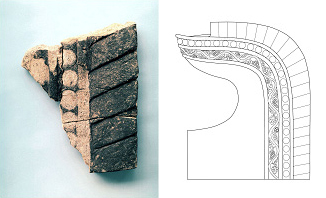
49.6 cm (length) x 38.7 cm (width)
(2)Wall pieces
The mid 7th century. In the possession of the Osaka City Cultural Properties Association.
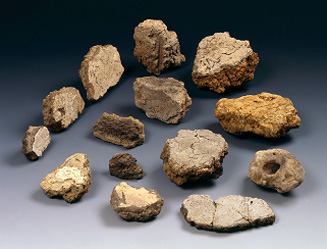
These pieces were discovered during an archaeological investigation of the valley to the east of the Naniwa Palace. A closer examination revealed that the wall pieces finished with white plaster were elaborately crafted, consisting of four layers―a base layer of mud plaster, a middle layer, a surface layer, and a layer of finish coat. The white plaster is made of volcanic ash, and these pieces resemble wall pieces discovered in Yamada Temple. The discovery of these wall pieces was one of the most important breakthroughs, proving the existence of a building with white walls on the premises of the Naniwa Palace of the earlier period.
(3) Wooden tablet with text written in Manyo-gana
(ancient Japanese syllabary using Chinese characters)
From the left: Actual object, infrared photograph,
measured drawing, and translation into modern Japanese
The mid 7th century. In the possession of the Osaka City Cultural Properties Association,
Osaka City-designated cultural property.
[ The actual object will be exhibited from June 21 to 30, 2014 only.
For the rest of the exhibition period, a replica will be shown. ]
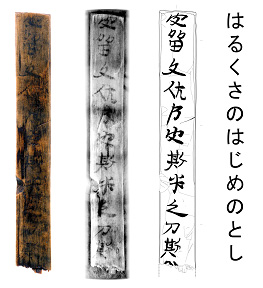
Longer than 18.50 cm (length) x 2.65 cm (width)
This wooden tablet dates to the mid 7th century. On the tablet, eleven Manyo-gana characters are written, which read “harukusa no hajime no toshi (literally meaning “the first year of spring grass”). This text is considered to be the oldest poem written in Manyo-gana, which uses each Chinese character as a phonetic symbol. The lower part of the tablet is broken and lost, so the text is considered to be part of a longer poem. This discovery contributed greatly to the study of the Japanese writing system and poems in ancient times.
(4) Bases of pillars unearthed from the Naniwa Palace Site
The 7th century. In the possession of the Osaka Center for Cultural Heritage.
These bases of pillars that had formed a colonnade were discovered during an excavation in the northwestern part of the Naniwa Palace Site. A new dating method* suggested that these pillars were made from trees that had been cut in the early 7th century. This finding was particularly useful for studying the layout of buildings on the premises of the Naniwa Palace.
*The method of dating is used to determine the age of a tree by measuring oxygen isotope ratios of tree-ring cellulose, which was developed by Professor Nakatsuka Takeshi, Research Institute for Humanity and Nature.
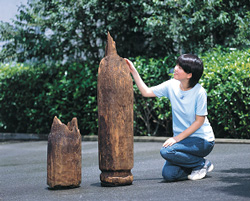
Left: 28 cm (diameter) x 60 cm (length)
Right: 31 cm (diameter) x 126 cm (length)
(Photo courtesy of the Osaka Center
for Cultural Heritage)
(5) A survey map of the estimated layout of buildings
on the premises of the Naniwa Palace
Present age. In the possession of Osaka Museum of History
(originally possessed by Dr. Yamane Tokutaro, and donated to the museum by Ms. Hamada Yuriko).
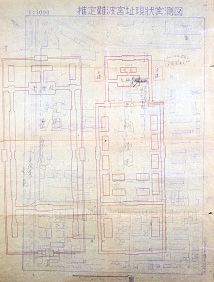
77.5 cm (length), 57.5 cm (width)
This is a diazo copy of a map showing the estimated layout of the buildings on the premises of the Naniwa Palace. On the reverse are some notes hand-written by Dr. Yamane Tokutaro, who led the excavation of the Naniwa Palace Site. With the traces of repeated revisions, this map reveals how the research team struggled to determine the layout of the buildings on the premises of the Naniwa Palace at an early stage of the excavation.

Shibi is a large ornamental roof tile placed at both ends of the ridge of a roof. The shibi tiles were used in important buildings in ancient times such as palaces and temples. This piece of shibi was discovered in November 1953 in the layer about 1.2 meters below ground during construction of the No. 13 Hoenzaka dwelling. This physical evidence convinced researchers of the existence of an ancient palace in the vicinity.